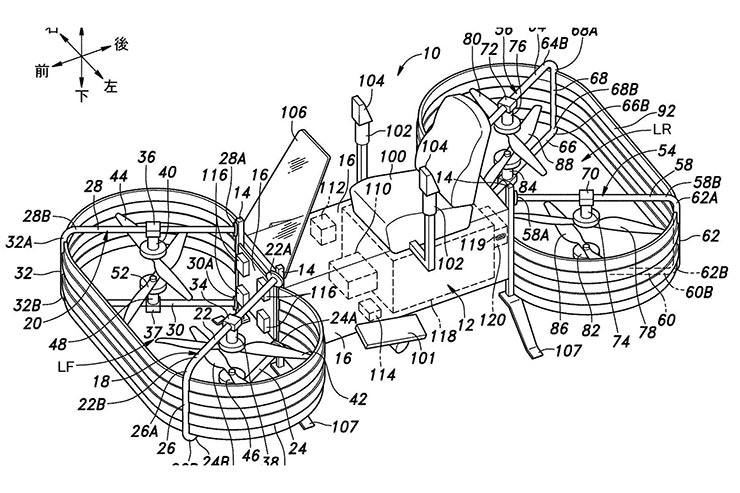Honda applies for flying bike patents
By Ben Purvis
Motorcycle Journalist
29.07.2019
The idea of a flying ‘bike’ has long been the stuff of sci-fi or ambitious crowd-funders promising technology that always seems to be just a couple of years away, but a new patent application in Japan shows that none other than Honda is working on just such an idea.
Of course, there’s always a question of just how much like a motorcycle these things can be. Wheels are a pretty integral part of anyone’s idea of a bike; ‘cycle’ means wheel, after all, coming from the same Greek word that gives us ‘circle’. Despite that, flying machines that carry a single, exposed rider seem destined to be given the ‘flying motorcycle’ name, whether it’s Ludovic Lazareth’s LMV946, the prototype demonstrated by Dubai’s police last year, or even the homemade hoverbike created by mad inventor Colin Furze. Even Star Wars got in on the act with the Speeder Bikes in Return of the Jedi.
Most of these things are mere flights of fantasy, but with a name like Honda attached to it, the idea of a flying bike becomes a lot more serious.
Of course, like most other so-called flying motorcycles, the machine shown in the Honda patent document is really a form of multi-copter, based on the same technology that brings us the commercial drones that have become such a normal part of modern life. As with those drones, it’s electric rather than petrol-powered.
In the Honda’s case, it’s actually an octo-copter, with eight sets of spinning blades, each with their own electric motor and arranged in four pairs. A simple box-section chassis connects the two ends of the machine and houses a large battery pack and the electronic units.
Control is achieved through a pair of joysticks, one either side, and while the seat looks like it’s out of a car the pilot straddles the main chassis, giving a cruiser-style riding position.
Quite what purpose the flying bike serves remains to be seen. With no ability to glide like an aeroplane or auto-rotate like a helicopter, there’s little chance of escape in the event of a complete power failure, making vehicles like this particularly difficult to be certified as airworthy. With eight motors, the Honda design could probably survive the loss of power to a couple of them, though, and presumably a parachute would be an option for more serious failures.
As usual with this sort of thing, don’t hold your breath for a production version. But Honda has got a growing presence in the field of air transport thanks to its revolutionary and successful HondaJet, so something like this might one day reach the skies.
Share on social media:
